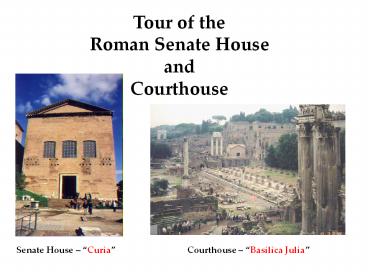Tour of the Roman Senate House and Courthouse - PowerPoint PPT Presentation
Title:
Tour of the Roman Senate House and Courthouse
Description:
Tour of the Roman Senate House and Courthouse Senate House Curia Courthouse Basilica Julia Roman Republic The Republic was broken into three ... – PowerPoint PPT presentation
Number of Views:177
Avg rating:3.0/5.0
Title: Tour of the Roman Senate House and Courthouse
1
Tour of the Roman Senate House and Courthouse
Senate House Curia
Courthouse Basilica Julia
2
Roman Republic The Republic was broken into three
branches of government.
- Executive
- two consuls (chief executives)
- 1 year terms
- elected
- commanded army
- directed government with advice of legislative
branch - consuls could veto each other
- Legislative
- Senate and two Assemblies
- wealthy citizens were members of the senate
- all other citizens were members of the two
assemblies - voted on laws and elected officials
- Judicial
- Praetors
- oversaw the entire legal system
- Elected officials
- heads of the Roman court system
The division of power is an example of Checks
and Balances
3
Both the Senate and Courthouse are located in the
Forum.
Senate House
Courthouse
4
Curia Here is a 3-D Model of the original senate
house. The current one was rebuilt by Mussolini
in the 1920s using original materials. The Curia
is where the Roman Senators would meet and
discuss politics.
5
These are the original senate doors that ancient
Roman senators would walk through to get inside
the senate house. The senators were one of the
three branches of the Roman Republic and were
responsible for foreign and financial policies.
In addition, the senators advised the two consuls
(leaders) of Rome. The senate was seen as the
most powerful of the three branches and was made
up of wealthy landowners.
6
This is a model of the interior of the Curia (the
senate house)
Besides the senate, the other groups in the
legislative branch were the two assemblies. The
assemblies consisted of all the lower class
citizens. They were responsible for voting on
laws and electing officials.
7
Judicial Branch The Courthouse Basilica Julia
A digital mock-up of what the courthouse looked
like in ancient times.
Today this is all that remains
The duty of the Judicial branch was to carry out
the laws of the Roman Empire in order to ensure
peace, stability and order. 180 magistrates
(judges) would oversee the court cases. They were
broken into 4 court rooms, so there were 45
judges at each trial. The accused were allowed to
have lawyers and the public was allowed to watch
the trials. Oftentimes lawyers would hire crowds
of spectators to applaud and jeer the opposing
council. Thus, court cases were a form of
entertainment for many Romans.
8
Digital representation of the interior of the
Basilica Julia, the building was divided into
four courts by simply putting up screens. The
magistrates, lawyers, and accused would be on the
bottom floor, while the spectators would be in
the balconies above.
9
Roman Laws The job of the judicial branch was to
uphold Roman laws. These laws were based upon the
concept of natural law which was first created
by Greek philosophers. The main idea of natural
law is that all humans possess the ability to
reason, so if reason was common to all people,
all people must be equal. If all human beings are
fundamentally alike, they should all be subject
to the same moral laws and principles. This is
the basic principle that underlies the modern
concept that people have natural rights that no
government can deny. If all humans must follow
these laws, then the laws must be made public
knowledge. In about 450 B.C. the Romans engraved
their laws on tablets called the Twelve Tables.
These laws were placed in the Forum for all to
view. This was the first time the Romans had ever
written down their laws, and these laws became
the foundation of the Roman Republic.
In 521 AD nearly 1,000 years after the Twelve
Tables were written, Emperor Justinian ordered
the compilation of all Roman laws from the time
period of the Tables onward. This written record
became known as the Justinian Code To explore the
Justinian Code you will be visiting the Basilica
Julia and will complete the tasks on your
handout.































